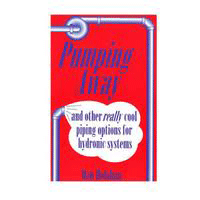Digital disruption
Industrial PVF distributors say e-Commerce may have a place in the market, ERP continues to meet needs.

When it comes to digital presence — e-Commerce, ERP software, social media, websites, etc. — the wholesale-distribution sector is somewhat all over the map. A recent survey conducted by Supply House Times asked several industrial PVF distributors to anonymously comment on their company’s utilization of and plans for adopting e-Commerce. Fifty percent of respondents already have e-Commerce in place, while about 25% have some form of e-Commerce in beta testing.
Opinions on whether or not the PVF space will shift toward using e-Commerce can be polarizing; some saying there is little to no demand in the market, while others say they are surprised by customer response.
One industrial PVF distributor who has had functioning e-Commerce in place for more than a year says the company anticipates increased demand for e-Commerce year over year. “We continue to build out more industrial PVF products,” the president and CEO says. “We think the market has already shifted to adopt e-Commerce when working out industrial PVF contracts.”
An opposing opinion comes from another PVF distributor who says it has had no requests from customers for e-Commerce, except for punch-out type sites. “We see no demand for it, and people want to use their own systems when ordering,” the marketing and development manager notes. “We don’t have universal part/SKU items either. Our customers are primarily an aging demographic and it is much easier to email us purchase orders.”
A few respondents believe that e-Commerce will eventually be the norm in the industrial PVF space, but the industry is years from universal adoption.
“I do see a market sift to e-Commerce, mostly on large-scale industrial projects. I think that contractors will be ordering entire levels of material many months in advance,” one distributor says. “But it won’t be via someone clicking on items and typing in quantities, it will be via their coordination software telling the distributors software when and how it needs the product.”
Another distributor points out that since customer service levels are so high in the PHCP-PVF sector, e-Commerce is not a universal desire. “As an industry, we offer a much better customer experience than retail does, so it’s not as much of a pain point dealing with a PVF or plumbing distributor as it is trying to go into a big-box store.”
One distributor with a relatively new e-Commerce solution says a new wave of consumers is coming up, so being versatile in your order options is important. “We have been very surprised at the acceptance rate of customers and web searchers out there,” the president and CEO says. “This new platform gives them the option to use our traditional sales channels or this new model, whatever they prefer is okay with us.”
The shift to e-Commerce may be a bit of case-by-case in the independent distribution space, but there’s no denying that overall customer expectations are changing in some capacity.
Matt Christensen, president of Distributor Data Solutions, says with the big-box competition targeting small to medium sized professionals, independent distributors should be thinking of e-Commerce.
“Research from one of our Digital Alliance partners is showing that 65-75% of contractors are doing some level of buying online, and this is increasing all the time. Even if it is a small percent, it is lost sales for the plumbing distributor,” Christensen says. “E-Commerce is no longer solely about trying to capture incremental business, for many it is retaining existing customers and offering the services that their customers want, when they want it.”
Christensen adds that e-Commerce gives customers the ability to place orders and do businesses after hours, providing the flexibility a busy contractor needs. “Allowing customers to research, purchase and do business the way they want with self-serve options that e-commerce provides. This omni-service approach provides the distributor the ability to let their customer quote a project after hours, place orders late in the day or electronically from the jobsite,” he says. “Perhaps they want to download spec sheets or view an installation video, or maybe check on the distributors’ inventory. For some customers it saves them time, for others it provides them flexibility.”
With the current disruption facing the supply chain, transparency is vital. Christensen points out that e-Commerce solutions can help provide that pellucidity. “Greater transparency in the supply chain, such as real time inventory direct from the manufacturers displayed on distributors’ e-commerce sites is important,” he says. “We also see larger manufacturers that are more project-driven providing greater transparency into the project fulfillment process. This can help contractors know when their order will arrive on the jobsite so that they can schedule their labor. It makes the channel more transparent, and accountable to the customer.”
A whole company approach
In addition to e-Commerce, there are many other digital tools distributors can take advantage of to remain competitive.
According to Barbara Jagoe, COO for DDI System, an ERP and e-Commerce solution for distributors, managing inventory is the top concern among distributor customers.
“Managing the inventory process from order to fulfillment is the number one priority for distribution businesses. The ability to identify and adjust products for sporadic and unusual demand was the key for servicing customers this past year,” says Jagoe. “As customer purchases fluctuate, the ability to quickly identify demand exceptions allows for confident, intelligent purchase forecasting.”
Jeff Johnson, vice president and general manager for Holmes Plumbing and Heating Supply Co., notes using ERP software has helped navigate the current disruption.
“Using distribution software has allowed us to have critical information at our fingertips at all times,” Johnson says. “We have been using DDI System for more than 10 years. It was a learning curve, but well worth the time and investment; it didn’t take long for our team to adapt to the system.”
Jagoe says the company knows there can be hesitation to change when it comes to adopting a new software. “After 25 years developing, installing and supporting ERP technology solely for distributors DDI System understands the focused needs and unique workflows of distribution companies,” she says. “We have a team of industry experts that collect and convert your precious historical data and hand hold your team through training and go live. Most of our customers are surprised how easy the transition process is and wish they had made the change earlier.”
ERP software offerings continue to develop new technologies to help distributors. According to Jagoe, here have been groundbreaking developments in e-Commerce capabilities for the mid-sized distributor, and a recognized need for a real-time connection between a distributor's ERP software that holds their customer, product and inventory data with their online storefront.
“Serving customers anytime and anywhere took on new meaning. Customers truly expected answers from distributors no matter where they were or what was going on in their areas,” Jagoe says. “New technologies are making distributors smarter and better prepared to take on the challenges of a changing marketplace and changing customer demands.”
From a project design viewpoint, Christensen says he sees manufacturers investing into configurators and BIM modeling, which brings more capabilities to contractors to help them design and manage a project.
“Distributors should think of technology investment as a ‘whole company’ approach. It’s no longer solely the role of the IT department,” Christensen says. “Every department has technological needs that either provide new services or tools to improve productivity. Distributors need to a continuous investment mindset and need to commit to a percent of technology investment every year.”
Looking for a reprint of this article?
From high-res PDFs to custom plaques, order your copy today!







